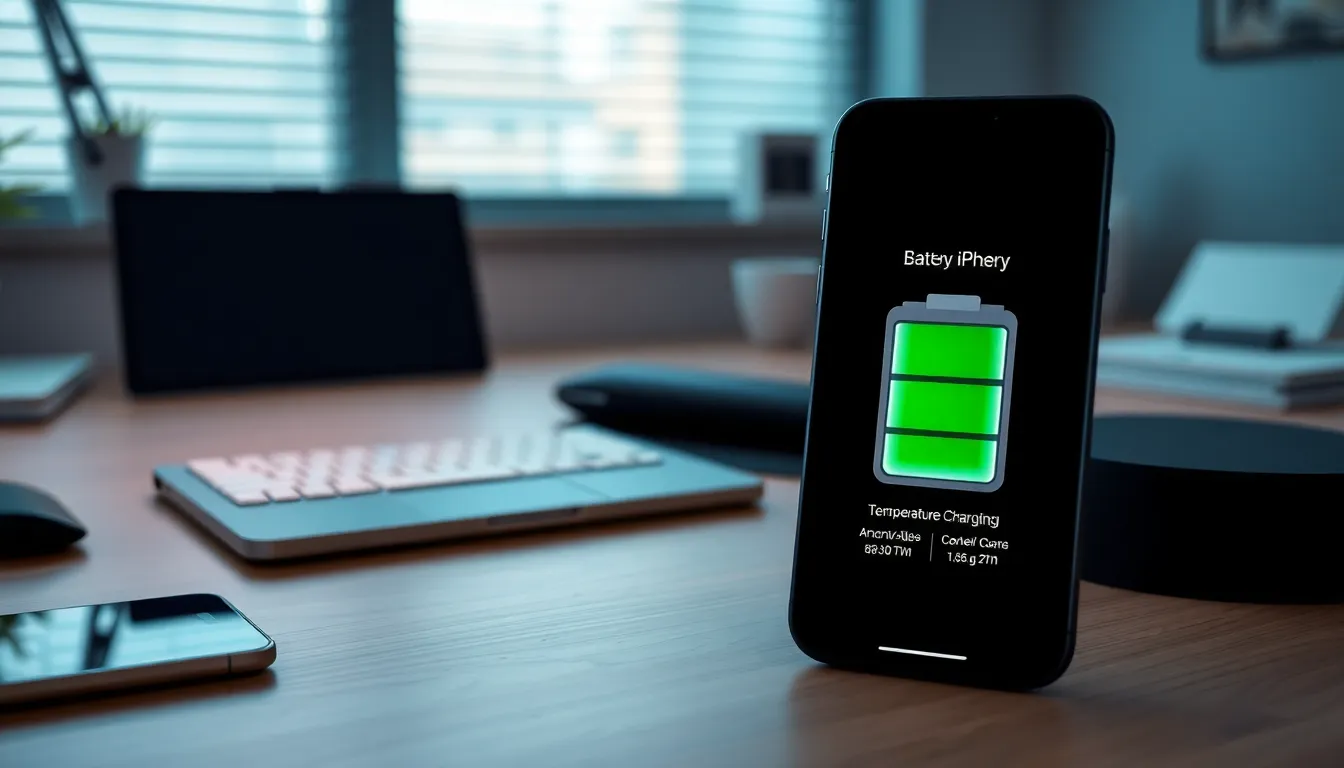Table of Contents
ToggleEver wondered what that mysterious “maximum capacity” percentage on your iPhone battery really means? You’re not alone. It’s like the secret sauce of battery health that Apple keeps under wraps, leaving many scratching their heads. Imagine your iPhone battery as a party guest—maximum capacity tells you just how much energy it can bring to the bash before it starts to fizzle out.
Understanding this concept is crucial for anyone who wants to keep their device running smoothly. It’s not just a number; it’s a window into your battery’s health and longevity. So grab your favorite drink and settle in, because unraveling the mystery of maximum capacity could save you from those dreaded low-battery moments. Plus, who doesn’t want to be the life of the party with a fully charged phone?
Understanding Maximum Capacity
Maximum capacity refers to the highest percentage of charge an iPhone battery can hold relative to its original design. This percentage declines over time and directly impacts a battery’s efficiency and longevity.
Definition of Maximum Capacity
Maximum capacity indicates how much energy the battery can store compared to when it was new. For example, a battery at 100% maximum capacity retains its full potential. A drop to 80% means it holds only 80% of the original charge. This metric helps users understand battery performance and informs them when it may be time for a replacement. Tracking maximum capacity becomes crucial for sustaining optimal device functionality over time.
Importance of Maximum Capacity in Battery Health
Understanding maximum capacity is vital for assessing overall battery health. A higher capacity percentage typically results in better performance and extended device usage between charges. Users experience longer usage times when the maximum capacity remains intact. Conversely, a lower maximum capacity signals diminished battery health and can lead to unexpected shutdowns. Monitoring this metric regularly aids in making informed decisions regarding battery maintenance and management.
Factors Affecting Maximum Capacity

Various elements influence the maximum capacity of an iPhone battery. Awareness of these factors helps optimize battery health and performance.
Age of the Battery
Batteries naturally degrade over time. With each charge cycle, the battery’s chemistry changes, reducing its maximum capacity. Typically, lithium-ion batteries experience significant capacity loss after 500 full charge cycles, leading to diminished performance. Users can expect around 80% of the original capacity after about two years of moderate use. Regularly checking the battery health in settings aids in understanding how age impacts performance.
Temperature and Usage
Extreme temperatures affect battery efficiency significantly. Heat accelerates chemical reactions within the battery, leading to quicker degradation of maximum capacity. Conversely, cold conditions can temporarily reduce the battery’s performance, causing sudden shutdowns despite having charge remaining. Optimal operating temperatures range between 32°F and 95°F (0°C and 35°C). Awareness of the environment and adjusting usage habits can enhance battery longevity.
Charging Habits
Charging practices play a vital role in battery health. Frequent use of fast charging can cause extra heat, leading to potential capacity loss over time. Leaving the device plugged in after reaching 100% can also strain the battery. Users should aim for partial charges between 20% and 80% for healthier battery maintenance. Employing these habits leads to better overall battery performance and extends its lifespan.
How to Check Maximum Capacity on iPhone
Checking the maximum capacity on an iPhone helps users understand battery health at a glance. Two main methods are available: using the Settings app or leveraging third-party applications.
Using Settings App
Accessing maximum capacity through the Settings app provides a straightforward approach. Users can navigate to Settings, then tap on Battery, followed by Battery Health. The maximum capacity percentage appears prominently, reflecting the current state of the battery compared to its original design. This feature also displays information on peak performance capability, offering insights into whether the battery operates at its best. Familiarity with these metrics enables users to evaluate performance and recognize when battery replacement may be necessary.
Third-Party Apps
Third-party apps offer additional options for checking battery capacity and health metrics. Numerous applications are available on the App Store, providing detailed insights beyond what the Settings app offers. Many of these apps can display real-time monitoring, including charge cycles, temperature, and historical data on battery performance. Users can download apps such as Battery Life or AccuBattery for comprehensive assessments. Utilizing these tools aids in understanding battery condition more thoroughly, ultimately assisting users in maintaining optimal battery health.
Implications of Maximum Capacity
Maximum capacity significantly influences an iPhone’s usability and efficiency. A lower maximum capacity can lead to persistent performance issues, such as slow app loading and frequent shutdowns during usage.
Performance Limitations
Performance limitations arise directly from a declining maximum capacity. A battery at 80% capacity may not support demanding tasks or high-performance gaming effectively. Users might notice reduced screen brightness or slower processing speeds as maximum capacity decreases. Frequent interruptions from unexpected shutdowns become more common when a battery only holds a fraction of its original charge. Regular monitoring of this percentage helps avoid these performance pitfalls, as it allows users to gauge when upgrades become necessary.
Upgrading Battery vs. New Device
Upgrading the battery can often be a cost-effective solution compared to investing in a new device. Replacing an iPhone battery often restores maximum capacity, enhancing performance and extending the phone’s lifespan. However, users must consider overall device age and performance. If a model shows other signs of wear, like faulty software or outdated hardware, investing in a new device may be more beneficial. Careful consideration of both options can help users make informed decisions about device longevity and functionality.
Understanding maximum capacity is essential for any iPhone user aiming to maintain optimal battery performance. This metric not only reflects the battery’s current health but also directly influences the device’s usability. By regularly checking maximum capacity and being mindful of factors that affect it, users can make informed decisions about battery care and replacement.
Adopting good charging habits and monitoring battery health can significantly extend the life of an iPhone’s battery. Whether opting for a replacement or considering a new device, keeping maximum capacity in mind ensures users enjoy a reliable and efficient smartphone experience.





